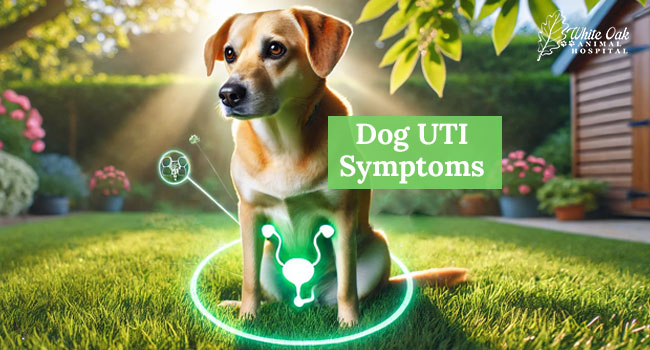
Recognizing dog UTI symptoms early is essential for effective treatment and to prevent complications. Common dog UTI symptoms include frequent urination, straining during urination, and changes in urine appearance or odor. Urinary tract infections (UTIs) in dogs are common health issues that can cause significant discomfort and lead to more severe problems if not addressed promptly.
Understanding these signs can help pet owners take timely action, ensuring their dogs receive the appropriate care. Seeking veterinary attention as soon as dog UTI symptoms are noticed is crucial to prevent the infection from worsening and to safeguard the overall health of the dog.
The Importance of Recognizing Dog UTI Symptoms Early
Ignoring dog UTI symptoms can lead to severe complications, including kidney infections and bladder stones, which require more intensive treatments and can be life-threatening. Early detection of dog UTI symptoms enables prompt treatment, reducing the risk of these complications and leading to faster recovery. When dog UTI symptoms are identified early, a simple course of antibiotics may be all that is needed to resolve the infection.
Additionally, early intervention helps prevent the spread of infection, reducing discomfort and promoting the dog’s overall health. UTIs can also impact a dog’s behavior, causing them to become irritable or lethargic. Recognizing these symptoms early allows for immediate action, helping to maintain a happy and healthy pet. Monitoring your dog’s urinary habits and behavior is key to early detection and effective management of dog UTI symptoms.
Dog UTI Symptoms: 7 Alarming Signs You Should Never Ignore
Frequent Urination
Frequent urination is a common symptom of a UTI in dogs. If a dog suddenly needs to go outside more often than usual, it could be a sign of irritation or infection in the urinary tract. This increased need to urinate is due to the body’s attempt to flush out the bacteria causing the infection. Recognizing frequent urination as a dog UTI symptom can help pet owners take swift action. Monitoring your dog’s bathroom habits closely is crucial to detecting this symptom early and seeking veterinary care promptly.
Straining to Urinate
 Straining or difficulty during urination is another significant dog UTI symptom. If a dog appears to be struggling or takes a long time to urinate, this could indicate inflammation or blockage in the urinary tract. This symptom occurs because the infection causes swelling and irritation, making it painful or difficult for the dog to pass urine. Recognizing straining as a dog UTI symptom is important because it can signal more serious underlying issues. Immediate veterinary consultation is necessary to determine the cause and start appropriate treatment.
Straining or difficulty during urination is another significant dog UTI symptom. If a dog appears to be struggling or takes a long time to urinate, this could indicate inflammation or blockage in the urinary tract. This symptom occurs because the infection causes swelling and irritation, making it painful or difficult for the dog to pass urine. Recognizing straining as a dog UTI symptom is important because it can signal more serious underlying issues. Immediate veterinary consultation is necessary to determine the cause and start appropriate treatment.
Blood in Urine
The presence of blood in a dog’s urine is a serious dog UTI symptom that requires immediate veterinary attention. Blood in the urine can appear as a pink or red tinge, indicating that the infection has caused inflammation or injury to the urinary tract. This symptom is often a sign of a severe infection or other complications, such as bladder stones. Identifying blood in urine early can help prevent the infection from progressing and allows for timely intervention. It’s important to contact a veterinarian if this symptom is noticed to ensure proper diagnosis and treatment.
Licking of Genital Area
Dogs may lick their genital area more frequently when experiencing a UTI due to the discomfort and irritation caused by the infection. This behavior is a dog’s attempt to soothe the painful symptoms associated with a UTI. Frequent licking can also introduce more bacteria into the urinary tract, worsening the infection. Recognizing this behavior as a dog UTI symptom can help pet owners understand that their dog is uncomfortable and in need of medical attention. Early recognition and treatment are crucial to alleviate discomfort and prevent the infection from spreading.
Strong or Foul-Smelling Urine
 A noticeable change in the odor of your dog’s urine can be a key indicator of a urinary tract infection. Strong or foul-smelling urine is often a result of bacteria multiplying in the urinary tract, leading to a distinct and unpleasant odor. This dog UTI symptom should not be ignored, as it can signal a developing infection that requires treatment. Paying attention to changes in your dog’s urine smell can help detect a UTI early. Immediate veterinary consultation is recommended to confirm the infection and begin appropriate treatment.
A noticeable change in the odor of your dog’s urine can be a key indicator of a urinary tract infection. Strong or foul-smelling urine is often a result of bacteria multiplying in the urinary tract, leading to a distinct and unpleasant odor. This dog UTI symptom should not be ignored, as it can signal a developing infection that requires treatment. Paying attention to changes in your dog’s urine smell can help detect a UTI early. Immediate veterinary consultation is recommended to confirm the infection and begin appropriate treatment.
Accidents in the House
 UTIs can lead to increased accidents indoors, even in house-trained dogs. This occurs because the infection causes a frequent and urgent need to urinate, making it difficult for the dog to control their bladder. Recognizing this behavior as a dog UTI symptom can help differentiate between a medical issue and a behavioral problem. If a dog suddenly starts having accidents in the house, it is important to consider a UTI as a possible cause and consult a veterinarian. Early diagnosis can prevent further accidents and ensure the dog receives the necessary treatment.
UTIs can lead to increased accidents indoors, even in house-trained dogs. This occurs because the infection causes a frequent and urgent need to urinate, making it difficult for the dog to control their bladder. Recognizing this behavior as a dog UTI symptom can help differentiate between a medical issue and a behavioral problem. If a dog suddenly starts having accidents in the house, it is important to consider a UTI as a possible cause and consult a veterinarian. Early diagnosis can prevent further accidents and ensure the dog receives the necessary treatment.
Visible Discomfort or Pain During Urination
Signs of pain or discomfort during urination, such as whimpering or a hunched posture, are significant indicators of a UTI in dogs. This dog UTI symptom suggests that the infection is causing irritation or inflammation in the urinary tract, making urination painful. Observing your dog for signs of discomfort and noting any changes in behavior during urination can help identify a UTI early. Prompt veterinary attention is necessary to alleviate pain and treat the infection effectively. Monitoring these signs closely is essential for early detection and successful management of dog UTI symptoms.
What to Do If You Notice Dog UTI Symptoms
 If you notice any dog UTI symptoms in your pet, it is important to act quickly. Start by observing the symptoms closely and note any changes in your dog’s behavior or urinary habits. Schedule a veterinary appointment as soon as possible to get a professional diagnosis. A veterinarian will likely perform a physical examination and recommend diagnostic tests, such as a urinalysis or urine culture, to determine the presence and cause of the infection.
If you notice any dog UTI symptoms in your pet, it is important to act quickly. Start by observing the symptoms closely and note any changes in your dog’s behavior or urinary habits. Schedule a veterinary appointment as soon as possible to get a professional diagnosis. A veterinarian will likely perform a physical examination and recommend diagnostic tests, such as a urinalysis or urine culture, to determine the presence and cause of the infection.
Early diagnosis of dog UTI symptoms allows for prompt treatment, reducing the risk of complications and promoting faster recovery. During the veterinary visit, discuss any symptoms you have noticed and ask about the best course of treatment for your dog’s condition. Follow all veterinary recommendations carefully, including administering any prescribed medications and ensuring your dog completes the full course of treatment. Monitoring your dog closely during and after treatment can help detect any recurring dog UTI symptoms, allowing for immediate intervention if needed.
Prevention Tips to Avoid Dog UTIs
 Preventing dog UTIs involves several practical measures. Ensure your dog has access to fresh, clean water at all times to help flush out bacteria from the urinary tract. Regular bathroom breaks are essential to prevent the accumulation of bacteria in the bladder. Maintaining good hygiene, such as regularly cleaning your dog’s genital area, can also reduce the risk of infection. Regular veterinary check-ups are crucial for early detection and prevention of UTIs, especially in dogs that are prone to recurrent infections.
Preventing dog UTIs involves several practical measures. Ensure your dog has access to fresh, clean water at all times to help flush out bacteria from the urinary tract. Regular bathroom breaks are essential to prevent the accumulation of bacteria in the bladder. Maintaining good hygiene, such as regularly cleaning your dog’s genital area, can also reduce the risk of infection. Regular veterinary check-ups are crucial for early detection and prevention of UTIs, especially in dogs that are prone to recurrent infections.
Dietary adjustments, such as incorporating foods that promote urinary health, can also help prevent UTIs. Foods rich in antioxidants and certain vitamins can support the urinary tract’s health and reduce the likelihood of infections. By taking these preventive measures, pet owners can minimize the risk of UTIs and keep their dogs healthy and comfortable. Being proactive in preventing dog UTI symptoms is key to ensuring your dog’s long-term health and well-being.
Treatment Options for Dog UTIs
Treating UTIs in dogs typically involves antibiotics to eliminate the bacterial infection. The type of antibiotic prescribed will depend on the specific bacteria identified through diagnostic tests. Pain relief medications may also be recommended to alleviate discomfort associated with dog UTI symptoms. It is important to follow the veterinarian’s instructions carefully and complete the full course of treatment, even if symptoms seem to improve. Failure to do so can result in the infection returning or becoming resistant to treatment. In addition to conventional treatments, natural and integrative therapies can support recovery.
Herbal supplements such as cranberry extract or PET | TAO Soothe Bladder may help prevent bacteria from adhering to the urinary tract walls. Traditional Chinese Veterinary Medicine (TCVM) treatments like acupuncture can also be beneficial in managing symptoms and promoting overall urinary health. It is essential to consult with a veterinarian before starting any natural remedies to ensure they are safe and appropriate for your dog.
Combining conventional and integrative therapies can provide a comprehensive approach to treating dog UTIs, addressing both the symptoms and the underlying causes of infection. Monitoring your dog closely during treatment is crucial to ensure the infection is fully resolved and to detect any recurring symptoms promptly.
 Recognizing and addressing dog UTI symptoms early is vital to prevent complications and ensure your pet’s swift recovery. Early detection allows for prompt treatment, which can prevent the infection from worsening and reduce the risk of more severe health issues. If you notice any dog UTI symptoms, seeking veterinary care immediately is crucial. White Oak Animal Hospital provides comprehensive and integrative treatment options for managing dog UTIs, combining conventional medicine with holistic approaches to promote overall health and well-being.
Recognizing and addressing dog UTI symptoms early is vital to prevent complications and ensure your pet’s swift recovery. Early detection allows for prompt treatment, which can prevent the infection from worsening and reduce the risk of more severe health issues. If you notice any dog UTI symptoms, seeking veterinary care immediately is crucial. White Oak Animal Hospital provides comprehensive and integrative treatment options for managing dog UTIs, combining conventional medicine with holistic approaches to promote overall health and well-being.
With over 28 years of experience in pet care, White Oak Animal Hospital is dedicated to offering personalized care tailored to each pet’s needs. Their unique offerings, including TCVM Telemedicine consultations, provide pet owners with access to specialized care that may not be available elsewhere. By choosing White Oak Animal Hospital, you can be confident that your dog will receive the best possible care for managing and preventing dog UTI symptoms. Don’t wait for symptoms to worsen; schedule a consultation today to ensure your pet’s health and comfort.
Frequently Asked Questions
How can I prevent UTIs in my dog?
Preventing UTIs in dogs involves ensuring proper hydration, regular vet visits, and maintaining good hygiene. Providing access to clean, fresh water helps flush bacteria from the urinary tract, reducing the risk of infection. Regular veterinary check-ups are essential for early detection and prevention, particularly for dogs prone to recurrent UTIs. Good hygiene, such as keeping the genital area clean, also helps prevent infections. Incorporating dietary changes, such as adding foods that support urinary health, can further help prevent UTIs. Following these preventive measures can significantly reduce the likelihood of UTIs in dogs.
Can a dog UTI resolve on its own?
It is not advisable to wait for a UTI to resolve on its own. Dog UTI symptoms typically require veterinary treatment to prevent the infection from spreading or worsening. Without proper treatment, a UTI can lead to more severe health issues, such as kidney infections or bladder stones, which can be life-threatening. Prompt veterinary intervention is essential to ensure the infection is treated effectively and to avoid complications. Always consult a veterinarian if you suspect your dog has a UTI, as timely treatment is crucial for a full recovery.
Are some dogs more prone to UTIs than others?
Yes, certain dogs are more susceptible to UTIs than others. Factors such as age, breed, and underlying health conditions can increase a dog’s risk of developing UTIs. Older dogs and those with weakened immune systems or pre-existing conditions like diabetes are more prone to infections. Female dogs are also more likely to develop UTIs due to their shorter urethra, which makes it easier for bacteria to reach the bladder. Understanding these risk factors can help pet owners take proactive steps to prevent UTIs and manage their dog’s health more effectively.
Related Posts
-
Traditional Dog UTI Treatment Options
Finding an effective dog UTI (urinary tract infection) treatment isn't hard. In fact, a UTI…
-
5 Dog Smegma Infection Symptoms Every Owner Must Recognize: Unveiling the Hidden Signs
Dog smegma infection is a condition that every pet owner should be aware of due…
-
5 Signs of Dog Cancer: Spotting Symptoms and Debunking Myths and Misconceptions
Dog cancer is, unfortunately, a prevalent concern among canine companions. It affects a significant number…
-
Effective Relief For Allergic Dog Symptoms
An allergic dog is easy to spot! Sure, all dogs itch and scratch, but you…









